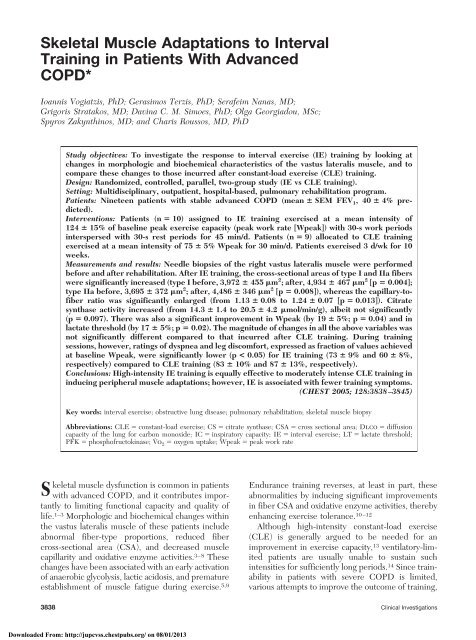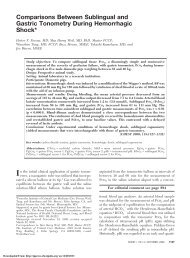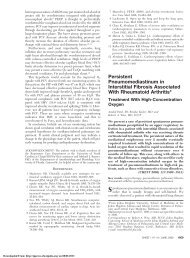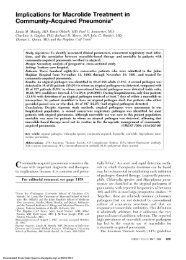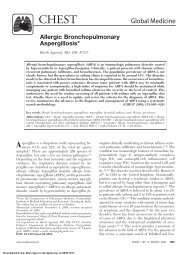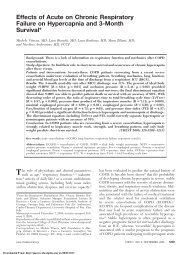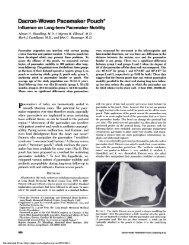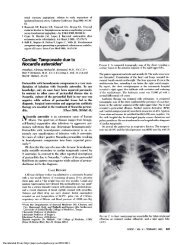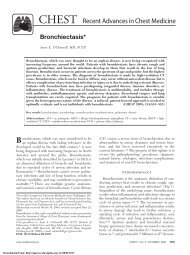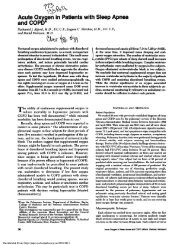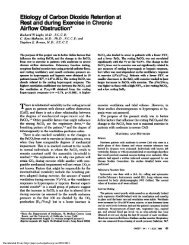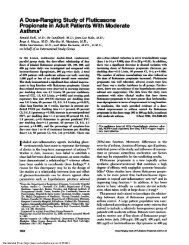Skeletal Muscle Adaptations to Interval Training in Patients With ...
Skeletal Muscle Adaptations to Interval Training in Patients With ...
Skeletal Muscle Adaptations to Interval Training in Patients With ...
You also want an ePaper? Increase the reach of your titles
YUMPU automatically turns print PDFs into web optimized ePapers that Google loves.
<strong>Skeletal</strong> <strong>Muscle</strong> <strong>Adaptations</strong> <strong>to</strong> <strong>Interval</strong><br />
<strong>Tra<strong>in</strong><strong>in</strong>g</strong> <strong>in</strong> <strong>Patients</strong> <strong>With</strong> Advanced<br />
COPD*<br />
Ioannis Vogiatzis, PhD; Gerasimos Terzis, PhD; Serafeim Nanas, MD;<br />
Grigoris Stratakos, MD; Dav<strong>in</strong>a C. M. Simoes, PhD; Olga Georgiadou, MSc;<br />
Spyros Zakynth<strong>in</strong>os, MD; and Charis Roussos, MD, PhD<br />
Study objectives: To <strong>in</strong>vestigate the response <strong>to</strong> <strong>in</strong>terval exercise (IE) tra<strong>in</strong><strong>in</strong>g by look<strong>in</strong>g at<br />
changes <strong>in</strong> morphologic and biochemical characteristics of the vastus lateralis muscle, and <strong>to</strong><br />
compare these changes <strong>to</strong> those <strong>in</strong>curred after constant-load exercise (CLE) tra<strong>in</strong><strong>in</strong>g.<br />
Design: Randomized, controlled, parallel, two-group study (IE vs CLE tra<strong>in</strong><strong>in</strong>g).<br />
Sett<strong>in</strong>g: Multidiscipl<strong>in</strong>ary, outpatient, hospital-based, pulmonary rehabilitation program.<br />
<strong>Patients</strong>: N<strong>in</strong>eteen patients with stable advanced COPD (mean SEM FEV 1, 40 4% predicted).<br />
Interventions: <strong>Patients</strong> (n 10) assigned <strong>to</strong> IE tra<strong>in</strong><strong>in</strong>g exercised at a mean <strong>in</strong>tensity of<br />
124 15% of basel<strong>in</strong>e peak exercise capacity (peak work rate [Wpeak]) with 30-s work periods<br />
<strong>in</strong>terspersed with 30-s rest periods for 45 m<strong>in</strong>/d. <strong>Patients</strong> (n 9) allocated <strong>to</strong> CLE tra<strong>in</strong><strong>in</strong>g<br />
exercised at a mean <strong>in</strong>tensity of 75 5% Wpeak for 30 m<strong>in</strong>/d. <strong>Patients</strong> exercised 3 d/wk for 10<br />
weeks.<br />
Measurements and results: Needle biopsies of the right vastus lateralis muscle were performed<br />
before and after rehabilitation. After IE tra<strong>in</strong><strong>in</strong>g, the cross-sectional areas of type I and IIa fibers<br />
were significantly <strong>in</strong>creased (type I before, 3,972 455 m 2 ; after, 4,934 467 m 2 [p 0.004];<br />
type IIa before, 3,695 372 m 2 ; after, 4,486 346 m 2 [p 0.008]), whereas the capillary-<strong>to</strong>fiber<br />
ratio was significantly enlarged (from 1.13 0.08 <strong>to</strong> 1.24 0.07 [p 0.013]). Citrate<br />
synthase activity <strong>in</strong>creased (from 14.3 1.4 <strong>to</strong> 20.5 4.2 mol/m<strong>in</strong>/g), albeit not significantly<br />
(p 0.097). There was also a significant improvement <strong>in</strong> Wpeak (by 19 5%; p 0.04) and <strong>in</strong><br />
lactate threshold (by 17 5%; p 0.02). The magnitude of changes <strong>in</strong> all the above variables was<br />
not significantly different compared <strong>to</strong> that <strong>in</strong>curred after CLE tra<strong>in</strong><strong>in</strong>g. Dur<strong>in</strong>g tra<strong>in</strong><strong>in</strong>g<br />
sessions, however, rat<strong>in</strong>gs of dyspnea and leg discomfort, expressed as fraction of values achieved<br />
at basel<strong>in</strong>e Wpeak, were significantly lower (p < 0.05) for IE tra<strong>in</strong><strong>in</strong>g (73 9% and 60 8%,<br />
respectively) compared <strong>to</strong> CLE tra<strong>in</strong><strong>in</strong>g (83 10% and 87 13%, respectively).<br />
Conclusions: High-<strong>in</strong>tensity IE tra<strong>in</strong><strong>in</strong>g is equally effective <strong>to</strong> moderately <strong>in</strong>tense CLE tra<strong>in</strong><strong>in</strong>g <strong>in</strong><br />
<strong>in</strong>duc<strong>in</strong>g peripheral muscle adaptations; however, IE is associated with fewer tra<strong>in</strong><strong>in</strong>g symp<strong>to</strong>ms.<br />
(CHEST 2005; 128:3838–3845)<br />
Key words: <strong>in</strong>terval exercise; obstructive lung disease; pulmonary rehabilitation; skeletal muscle biopsy<br />
Abbreviations: CLE constant-load exercise; CS citrate synthase; CSA cross sectional area; Dlco diffusion<br />
capacity of the lung for carbon monoxide; IC <strong>in</strong>spira<strong>to</strong>ry capacity; IE <strong>in</strong>terval exercise; LT lactate threshold;<br />
PFK phosphofruc<strong>to</strong>k<strong>in</strong>ase; V˙ o 2 oxygen uptake; Wpeak peak work rate<br />
<strong>Skeletal</strong> muscle dysfunction is common <strong>in</strong> patients<br />
with advanced COPD, and it contributes importantly<br />
<strong>to</strong> limit<strong>in</strong>g functional capacity and quality of<br />
life. 1–3 Morphologic and biochemical changes with<strong>in</strong><br />
the vastus lateralis muscle of these patients <strong>in</strong>clude<br />
abnormal fiber-type proportions, reduced fiber<br />
cross-sectional area (CSA), and decreased muscle<br />
capillarity and oxidative enzyme activities. 3–8 These<br />
changes have been associated with an early activation<br />
of anaerobic glycolysis, lactic acidosis, and premature<br />
establishment of muscle fatigue dur<strong>in</strong>g exercise. 5,9<br />
Endurance tra<strong>in</strong><strong>in</strong>g reverses, at least <strong>in</strong> part, these<br />
abnormalities by <strong>in</strong>duc<strong>in</strong>g significant improvements<br />
<strong>in</strong> fiber CSA and oxidative enzyme activities, thereby<br />
enhanc<strong>in</strong>g exercise <strong>to</strong>lerance. 10–12<br />
Although high-<strong>in</strong>tensity constant-load exercise<br />
(CLE) is generally argued <strong>to</strong> be needed for an<br />
improvement <strong>in</strong> exercise capacity, 13 ventila<strong>to</strong>ry-limited<br />
patients are usually unable <strong>to</strong> susta<strong>in</strong> such<br />
<strong>in</strong>tensities for sufficiently long periods. 14 S<strong>in</strong>ce tra<strong>in</strong>ability<br />
<strong>in</strong> patients with severe COPD is limited,<br />
various attempts <strong>to</strong> improve the outcome of tra<strong>in</strong><strong>in</strong>g,<br />
3838 Cl<strong>in</strong>ical Investigations<br />
Downloaded From: http://jupcvss.chestpubs.org/ on 08/01/2013
such as oxygen supplementation or cont<strong>in</strong>uous positive<br />
airway pressure, have been employed. 13 An<br />
alternative approach that allows high-<strong>in</strong>tensity exercise<br />
<strong>to</strong> be performed for sufficiently long periods of<br />
time is <strong>in</strong>terval exercise (IE). In healthy subjects with<br />
this type of exercise, it is possible <strong>to</strong> impose maximal<br />
loads on both muscles and oxygen-transport<strong>in</strong>g organs<br />
without significant engagement of anaerobic<br />
processes, thus allow<strong>in</strong>g a great amount of work <strong>to</strong> be<br />
performed before exhaustion sets <strong>in</strong>. 15 In patients<br />
with advanced COPD, IE tra<strong>in</strong><strong>in</strong>g, consist<strong>in</strong>g of<br />
repeated bouts of high or even maximal-<strong>in</strong>tensity<br />
work separated by periods of lower <strong>in</strong>tensity work or<br />
rest, has been shown <strong>to</strong> be associated with a small<br />
<strong>in</strong>crease <strong>in</strong> lactate concentration, stable ventilation,<br />
and low symp<strong>to</strong>ms of dyspnea and leg discomfort,<br />
thus allow<strong>in</strong>g the <strong>to</strong>tal amount of work performed <strong>to</strong><br />
be significantly greater than at CLE tra<strong>in</strong><strong>in</strong>g. 16–17<br />
In addition, application of IE tra<strong>in</strong><strong>in</strong>g <strong>in</strong><strong>to</strong> pulmonary<br />
rehabilitation has been shown <strong>to</strong> be an equally<br />
effective alternative <strong>to</strong> moderately <strong>in</strong>tense CLE<br />
tra<strong>in</strong><strong>in</strong>g <strong>in</strong> terms of improv<strong>in</strong>g exercise <strong>to</strong>lerance and<br />
quality of life. 18 As there is evidence 19–20 that patients<br />
with advanced COPD have a significant metabolic<br />
reserve capacity that is only evident when<br />
muscle activity is somewhat freed from ventila<strong>to</strong>ry<br />
constra<strong>in</strong>ts, it was hypothesized that application of<br />
high-<strong>in</strong>tensity IE tra<strong>in</strong><strong>in</strong>g <strong>in</strong> the rehabilitation of<br />
these patients would <strong>in</strong>duce significant peripheral<br />
muscle adaptations lead<strong>in</strong>g <strong>to</strong> improvements <strong>in</strong> exercise<br />
<strong>to</strong>lerance. Consequently, the purpose of the<br />
present study was primarily <strong>to</strong> <strong>in</strong>vestigate the response<br />
<strong>to</strong> high-<strong>in</strong>tensity IE tra<strong>in</strong><strong>in</strong>g by specifically<br />
look<strong>in</strong>g at changes <strong>in</strong> morphologic and biochemical<br />
characteristics of the vastus lateralis muscle. In<br />
addition, we compared the magnitude of peripheral<br />
muscle adaptations <strong>in</strong>duced by high-<strong>in</strong>tensity IE<br />
tra<strong>in</strong><strong>in</strong>g <strong>to</strong> that <strong>in</strong>curred after implementation of the<br />
commonly applied moderately <strong>in</strong>tense CLE tra<strong>in</strong><strong>in</strong>g<br />
modality.<br />
*From the Department of Critical Care Medic<strong>in</strong>e and Pulmonary<br />
Services (Drs. Nanas, Stratakos, Simoes, Zakynth<strong>in</strong>os, and Roussos),<br />
Pulmonary Rehabilitation Centre, Evangelismos Hospital,<br />
and Thorax Foundation “M. Simou and G.P. Livanos Labora<strong>to</strong>ries”;<br />
Department of Physical Education and Sport Science (Drs.<br />
Terzis and Vogiatzis, and Ms. Georgiadou), National & Kapodistrian<br />
University of Athens, Athens, Greece.<br />
This work was supported <strong>in</strong> part by the European Community<br />
CARED FP5 project (No. QLG5-CT-2002–0893) and by the<br />
Thorax Foundation.<br />
Manuscript received March 4, 2005; revision accepted September<br />
26, 2005.<br />
Reproduction of this article is prohibited without written permission<br />
from the American College of Chest Physicians (www.chestjournal.<br />
org/misc/repr<strong>in</strong>ts.shtml).<br />
Correspondence <strong>to</strong>: Ioannis Vogiatzis, PhD, National & Kapodistrian<br />
University of Athens, Medical School, Thorax Foundation 3<br />
Ploutarhou Str. 106 75, Athens, Greece; e-mail:gianvog@phed.<br />
uoa.gr<br />
Subjects<br />
Materials and Methods<br />
<strong>Patients</strong> <strong>in</strong>cluded 16 men and 3 women with stable, advanced<br />
COPD who satisfied the follow<strong>in</strong>g criteria: (1) postbronchodila<strong>to</strong>r<br />
FEV 1 50% of predicted and FEV 1/FVC 70% without<br />
significant reversibility ( 12% change of the <strong>in</strong>itial FEV 1 value),<br />
(2) optimized medical therapy, and (3) no cl<strong>in</strong>ical evidence of<br />
exercise-limit<strong>in</strong>g cardiovascular or neuromuscular diseases. <strong>Patients</strong><br />
signed an <strong>in</strong>formed consent form that was approved by the<br />
University Ethics Committee.<br />
Study Design<br />
The study was designed as a randomized, controlled, parallel,<br />
two-group study. Once it was verified that patients met the<br />
selection criteria, they were randomly assigned <strong>to</strong> one of the two<br />
tra<strong>in</strong><strong>in</strong>g modalities: IE or CLE. Stratified randomization was<br />
used <strong>to</strong> achieve approximate balance of certa<strong>in</strong> characteristics<br />
(Table 1), <strong>in</strong>clud<strong>in</strong>g FEV 1 ( 40 or 40% of predicted) and<br />
peak work rate (Wpeak) [ 50 or 50 W] that was assessed by<br />
a ramp-<strong>in</strong>cremental cycle ergometer test.<br />
Pulmonary Function Assessment<br />
Spirometry and diffusion capacity of the lung for carbon<br />
monoxide (Dlco) were performed (Masterlab; Jaeger; Wurzburg,<br />
Germany) accord<strong>in</strong>g <strong>to</strong> recommended techniques. 21 Arterial<br />
blood gas was also analyzed at rest (ABL330; Radiometer;<br />
Copenhagen, Denmark).<br />
Rehabilitation Program<br />
The rehabilitation program was multidiscipl<strong>in</strong>ary and <strong>in</strong>cluded<br />
supervised exercise tra<strong>in</strong><strong>in</strong>g, breath<strong>in</strong>g control and relaxation<br />
techniques, methods of clearance of pulmonary secretions, disease<br />
education, dietary advice, and psychological support on<br />
issues relat<strong>in</strong>g <strong>to</strong> chronic disability. Similarly <strong>to</strong> our previous<br />
rehabilitation study, 18 the exercise prescription was designed <strong>to</strong><br />
present patients with a similar overall tra<strong>in</strong><strong>in</strong>g load. <strong>Patients</strong><br />
assigned <strong>to</strong> the IE group were <strong>in</strong>structed <strong>to</strong> exercise on electromagnetically<br />
braked cycle ergometers (Cateye Ergociser,<br />
ECl600; Cat Eye; Osaka, Japan) at an <strong>in</strong>tensity <strong>in</strong>itially targeted<br />
Table 1—Basel<strong>in</strong>e Lung Function Characteristics<br />
Between the IE and the CLE <strong>Tra<strong>in</strong><strong>in</strong>g</strong> Groups*<br />
Characteristics IE (n 10) CLE (n 9)<br />
Age, yr 64 3 67 2<br />
Body mass <strong>in</strong>dex,<br />
25.9 1.2 26.9 1.3<br />
kg/m 2<br />
FEV1, L (% predicted) 1.12 0.15 (44 6) 1.07 0.16 (39 6)<br />
FVC, L (% predicted) 2.64 0.28 (82 8) 2.67 0.27 (75 7)<br />
FEV1/FVC, % 42 4 44 6<br />
Dlco, % predicted 51 9 47 8<br />
IC, % predicted 71 6 71 12<br />
Pao2,mmHg 69 6 64 4<br />
Paco2,mmHg 39 1 41 1<br />
pH 7.43 0.01 7.44 0.01<br />
Arterial oxygen<br />
saturation, %<br />
94 1 92 1<br />
*Data are presented as mean SEM.<br />
www.chestjournal.org CHEST / 128 /6/DECEMBER, 2005 3839<br />
Downloaded From: http://jupcvss.chestpubs.org/ on 08/01/2013
<strong>to</strong> 100% of Wpeak, assessed prior <strong>to</strong> rehabilitation by a ramp<strong>in</strong>cremental<br />
cycle ergometer test (see below), with 30 s of work<br />
<strong>in</strong>terspersed with 30-s rest periods for 45 m<strong>in</strong>/d, 3 days per week,<br />
for 10 weeks. <strong>Patients</strong> assigned <strong>to</strong> the CLE group were <strong>in</strong>structed<br />
<strong>to</strong> exercise for the same weekly frequency and <strong>to</strong>tal duration as<br />
the IE group but at an <strong>in</strong>tensity that was <strong>in</strong>itially equivalent <strong>to</strong><br />
60% of basel<strong>in</strong>e Wpeak for 30 m<strong>in</strong> each time. Therefore, at the<br />
outset of the study, the <strong>to</strong>tal amount of work done per session by<br />
each member of the IE group was designed <strong>to</strong> equate the work<br />
that these patients would have done had they been assigned <strong>to</strong><br />
the CLE group. As tra<strong>in</strong><strong>in</strong>g pr<strong>in</strong>ciples require the tra<strong>in</strong><strong>in</strong>g<br />
<strong>in</strong>tensity <strong>to</strong> parallel the improvement <strong>in</strong> physical fitness, 13 the<br />
weekly tra<strong>in</strong><strong>in</strong>g load for the IE group was designed <strong>to</strong> represent<br />
100% dur<strong>in</strong>g weeks 1 <strong>to</strong> 3, 120% dur<strong>in</strong>g weeks 4 <strong>to</strong> 6, and 140%<br />
of Wpeak dur<strong>in</strong>g the last 4 weeks. For the CLE group, the load<br />
was designed <strong>to</strong> represent 60%, 70%, and 80% of Wpeak,<br />
respectively, for the three weekly periods. Supervision dur<strong>in</strong>g<br />
tra<strong>in</strong><strong>in</strong>g <strong>in</strong>volved measurements of pulse oxygen saturation, heart<br />
rate, and sensation of dyspnea and leg discomfort. Dur<strong>in</strong>g<br />
tra<strong>in</strong><strong>in</strong>g, supplemental oxygen was provided at a rate of 1.5 <strong>to</strong> 2.0<br />
L/m<strong>in</strong> <strong>in</strong> six patients <strong>in</strong> the IE group and four patients <strong>in</strong> the CLE<br />
group.<br />
<strong>Muscle</strong> Biopsy<br />
<strong>With</strong><strong>in</strong> a week before and after the rehabilitation program,<br />
percutaneous biopsies of the right vastus lateralis muscle were<br />
performed at mid-thigh (15 cm above the patella) as described by<br />
Bengstrom. 22 Briefly after local anesthesia with 1.5 mL of<br />
lidoca<strong>in</strong>e 2%, a 1-cm sk<strong>in</strong> <strong>in</strong>cision was performed and muscle<br />
samples were obta<strong>in</strong>ed. Samples were placed <strong>in</strong> embedd<strong>in</strong>g<br />
compound and immediately frozen <strong>in</strong> isopentane precooled <strong>to</strong> its<br />
freez<strong>in</strong>g po<strong>in</strong>t. All samples were kept at 80°C until the day of<br />
analysis. The pretra<strong>in</strong><strong>in</strong>g and posttra<strong>in</strong><strong>in</strong>g muscle biopsy samples<br />
were obta<strong>in</strong>ed 10-cm apart from each other.<br />
<strong>Skeletal</strong> <strong>Muscle</strong> Analysis<br />
Fiber Typ<strong>in</strong>g, CSA, and Capillarization: All muscle specimens<br />
were coded and analyzed without knowledge of the cl<strong>in</strong>ical data.<br />
Samples obta<strong>in</strong>ed before and after the tra<strong>in</strong><strong>in</strong>g period were<br />
analyzed <strong>in</strong> pairs at the same time. Cryostat transverse sections of<br />
10 m <strong>in</strong> thickness were cut at 20°C and were sta<strong>in</strong>ed for<br />
myofibrillar adenos<strong>in</strong>e triphosphatase after pre<strong>in</strong>cubation at pH<br />
values of 4.3, 4.6, and 10.3. 23–24 A mean of 331 14 muscle<br />
fibers were analyzed from each slice and classified as type I, IIa,<br />
or IIb. The CSA of a m<strong>in</strong>imum of 200 fibers was measured <strong>in</strong><br />
each slice with an image analysis system (ImagePro; Media<br />
Cybernetics; Silver Spr<strong>in</strong>g, MD) at a known and calibrated<br />
magnification. A-amylase-periodic acid shift was used <strong>to</strong> visualize<br />
capillaries. The number of capillaries identified <strong>in</strong> a certa<strong>in</strong> area<br />
was divided by the number of fibers found <strong>in</strong> the correspond<strong>in</strong>g<br />
muscle section. 25<br />
Enzyme Activity: The activities of phosphofruc<strong>to</strong>k<strong>in</strong>ase (PFK)<br />
[enzyme code 2.7.1.11] and citrate synthase (CS) [enzyme code<br />
4.1.3.7] were studied us<strong>in</strong>g described spectropho<strong>to</strong>metric techniques.<br />
26<br />
Assessment of Exercise Capacity<br />
Before and after the tra<strong>in</strong><strong>in</strong>g program, an <strong>in</strong>cremental pro<strong>to</strong>col<br />
was performed on an electromagnetically braked cycle ergometer<br />
(Ergol<strong>in</strong>e 800; SensorMedics; Yorba L<strong>in</strong>da, CA). After 3-m<strong>in</strong> of<br />
basel<strong>in</strong>e measurements, followed by 3-m<strong>in</strong> of unloaded pedal<strong>in</strong>g,<br />
the work rate was <strong>in</strong>creased every m<strong>in</strong> by 5 or 10 W <strong>to</strong> the limit<br />
of <strong>to</strong>lerance while patients ma<strong>in</strong>ta<strong>in</strong>ed a pedal<strong>in</strong>g frequency of 60<br />
revolutions/m<strong>in</strong>. Gas exchange and ventila<strong>to</strong>ry variables were<br />
recorded breath-by-breath (V˙ max 229; SensorMedics). At basel<strong>in</strong>e,<br />
dur<strong>in</strong>g unloaded cycl<strong>in</strong>g and <strong>in</strong>cremental exercise, patients<br />
performed <strong>in</strong>spira<strong>to</strong>ry capacity (IC) maneuvers at 3-m<strong>in</strong> <strong>in</strong>tervals<br />
accord<strong>in</strong>g <strong>to</strong> previously described methods. 27 The V-slope technique<br />
was used <strong>to</strong> detect the oxygen uptake (V˙ o 2) at which the<br />
lactate threshold (LT) occurred. 28 The modified Borg Scale 29 was<br />
used <strong>to</strong> rate the magnitude of dyspnea and leg discomfort.<br />
Statistical Analysis<br />
Data are presented as mean SEM. The with<strong>in</strong>-group and<br />
between-group differences were analyzed us<strong>in</strong>g repeated-measures<br />
analysis of variance. Between-group comparisons of basel<strong>in</strong>e<br />
characteristics were carried out by unpaired t test. The level<br />
of significance was set at p 0.05.<br />
Results<br />
Patient Characteristics<br />
As shown <strong>in</strong> Table 1, patients <strong>in</strong> both groups were<br />
characterized by severe airflow limitation, moderate<br />
hypoxemia without carbon dioxide retention at rest,<br />
and reduced values for Dlco and IC. At the outset<br />
of the study pulmonary function, exercise capacity<br />
and morphologic characteristics of the vastus lateralis<br />
muscle were not significantly different between<br />
the two groups, whereas exercise capacity was severely<br />
compromised <strong>in</strong> both groups (Tables 1–3).<br />
<strong>Tra<strong>in</strong><strong>in</strong>g</strong> Program<br />
The average tra<strong>in</strong><strong>in</strong>g <strong>in</strong>tensity susta<strong>in</strong>ed at 100%<br />
and 60% of basel<strong>in</strong>e Wpeak dur<strong>in</strong>g IE and CLE<br />
tra<strong>in</strong><strong>in</strong>g was achieved at the fifth and fourth sessions,<br />
respectively. The mean <strong>in</strong>tensity susta<strong>in</strong>ed dur<strong>in</strong>g<br />
tra<strong>in</strong><strong>in</strong>g <strong>in</strong>creased progressively <strong>in</strong> the IE group<br />
and corresponded <strong>to</strong> 105 13%, 130 13%, and<br />
138 16% of basel<strong>in</strong>e Wpeak and <strong>to</strong> 66 3%,<br />
Table 2—Vastus Lateralis <strong>Muscle</strong> Characteristics of<br />
<strong>Patients</strong> Assigned <strong>to</strong> the IE and CLE <strong>Tra<strong>in</strong><strong>in</strong>g</strong> Groups<br />
at the Outset of the Study*<br />
Characteristics IE (n 10) CLE (n 9)<br />
Fiber-type distribution, %<br />
Type I 36 5 40 5<br />
Type IIa 50 6 46 6<br />
Type IIb<br />
CSA, m<br />
13 2 13 3<br />
2<br />
Type I 3,972 455 4,634 262<br />
Type IIa 3,695 372 3,795 231<br />
Type IIb 3,027 407 3,127 218<br />
Capillary-<strong>to</strong>-fiber ratio 1.13 0.08 1.30 0.09<br />
Capillary density, capillaries/mm 2<br />
266 18 268 12<br />
CS activity, mol/m<strong>in</strong>/g 14.3 1.4 21.6 2.6†<br />
PFK activity, mol/m<strong>in</strong>/g 61.3 22.2 63.8 11.7<br />
*Data are presented as mean SEM.<br />
†p 0.05<br />
3840 Cl<strong>in</strong>ical Investigations<br />
Downloaded From: http://jupcvss.chestpubs.org/ on 08/01/2013
Table 3—Responses <strong>to</strong> the Incremental Exercise Test<br />
Between the IE and the CLE <strong>Tra<strong>in</strong><strong>in</strong>g</strong> Groups*<br />
Characteristics IE (n 10) CLE (n 9)<br />
Wpeak, W 53 9 61 8<br />
Peak V˙ o2, L/m<strong>in</strong><br />
Peak V˙ co2, L/m<strong>in</strong><br />
0.87 0.09<br />
0.89 0.11<br />
0.97 0.10<br />
0.96 0.10<br />
LT, L/m<strong>in</strong> 0.64 0.05 0.68 0.03<br />
Peak V˙ e, L/m<strong>in</strong> 37.9 4.2 37.2 3.3<br />
Peak V˙ e/MVV, % 88 7 86 6<br />
Peak respira<strong>to</strong>ry rate, breaths/m<strong>in</strong> 33 3 34 2<br />
Peak VT, L 1.19 0.13 1.12 0.05<br />
Change <strong>in</strong> IC, L 0.49 0.09 0.63 0.07<br />
Peak heart rate, beats/m<strong>in</strong> 132 6 122 10<br />
Peak pulse oxygen saturation, % 93 1 93 1<br />
Peak dyspnea, Borg 4.1 0.5 4.1 0.6<br />
Peak leg fatigue, Borg 4.8 0.7 4.0 0.6<br />
*Data are presented as mean SEM. V˙ co2 carbon dioxide output;<br />
V˙ e m<strong>in</strong>ute ventilation; MVV maximum voluntary ventilation;<br />
VT tidal volume.<br />
75 5%, and 85 5% of basel<strong>in</strong>e Wpeak <strong>in</strong> the<br />
CLE group at weeks 3, 6 and 9, respectively. Exam<strong>in</strong>ation<br />
of the mean tra<strong>in</strong><strong>in</strong>g <strong>in</strong>tensities revealed that<br />
the <strong>to</strong>tal amount of work performed by the two<br />
groups dur<strong>in</strong>g tra<strong>in</strong><strong>in</strong>g was not significantly different.<br />
However, dur<strong>in</strong>g the tra<strong>in</strong><strong>in</strong>g sessions rat<strong>in</strong>gs of<br />
dyspnea and leg discomfort, expressed as fraction of<br />
the peak values achieved at basel<strong>in</strong>e Wpeak, were<br />
significantly (p 0.05) lower for IE tra<strong>in</strong><strong>in</strong>g<br />
(73 9% and 60 8%, respectively) compared <strong>to</strong><br />
CLE tra<strong>in</strong><strong>in</strong>g (83 10% and 87 13%, respectively)<br />
[Fig 1].<br />
<strong>Skeletal</strong> <strong>Muscle</strong> <strong>Adaptations</strong><br />
Fiber Typ<strong>in</strong>g and CSA Determ<strong>in</strong>ation: The proportion<br />
of type I and type IIa fibers changed very little<br />
after both tra<strong>in</strong><strong>in</strong>g modalities (IE by 3% and 2%,<br />
respectively; CLE by 2% and 1%, respectively). However,<br />
the proportion of type IIb fibers was significantly<br />
reduced <strong>in</strong> both groups (IE: from 13 2<strong>to</strong>7 1%<br />
[p 0.001]; CLE: from 13 3<strong>to</strong>9 2% [p 0.02]).<br />
After rehabilitation, the CSA of type I and type IIa<br />
fibers was <strong>in</strong>creased <strong>in</strong> both groups (IE: type I before,<br />
3,972 455 m 2 ; after, 4,934 468 m 2 [p 0.004];<br />
type IIa before, 3,695 372 m 2 ; after, 4,486 346<br />
m 2 [p 0.008]); (CLE: type I before, 4,634 262<br />
m 2 ; after, 5,119 273 m 2 [p 0.012]; type IIa<br />
before, 3,795 231 m 2 ; after, 4,183 180 m 2<br />
[p 0.021]) [Fig 2, 3]. The CSA of type IIb fibers<br />
<strong>in</strong>creased significantly (p 0.001) only after CLE<br />
tra<strong>in</strong><strong>in</strong>g (from 3,127 218 <strong>to</strong> 3,520 204 m 2 ). The<br />
magnitude of change <strong>in</strong> fiber type and CSA was not<br />
significantly different between groups.<br />
<strong>Muscle</strong> Capillarization: The capillary-<strong>to</strong>-fiber ratio<br />
was significantly enlarged after tra<strong>in</strong><strong>in</strong>g (IE, from<br />
Figure 1. Average values for tra<strong>in</strong><strong>in</strong>g <strong>in</strong>tensity susta<strong>in</strong>ed dur<strong>in</strong>g the program sessions (<strong>to</strong>p left, A),<br />
cardiac frequency (fc) [bot<strong>to</strong>m left, B], dyspnea (<strong>to</strong>p right, C), and leg discomfort (bot<strong>to</strong>m right, D) for<br />
the IE (open circles) and CLE (closed circles) tra<strong>in</strong><strong>in</strong>g groups. All parameters are expressed as fractions<br />
of the peak values achieved at Wpeak dur<strong>in</strong>g the basel<strong>in</strong>e <strong>in</strong>cremental test. Data are shown as<br />
mean SEM.<br />
www.chestjournal.org CHEST / 128 /6/DECEMBER, 2005 3841<br />
Downloaded From: http://jupcvss.chestpubs.org/ on 08/01/2013
Figure 2. Fiber-type distribution (percentage) of the vastus<br />
lateralis muscle before (open squares) and after (gray squares)<br />
tra<strong>in</strong><strong>in</strong>g for the IE group (<strong>to</strong>p, A) and the CLE group (bot<strong>to</strong>m, B).<br />
*p 0.05, comparisons between before (open squares) and after<br />
tra<strong>in</strong><strong>in</strong>g (gray squares). Data are presented as mean SEM.<br />
1.13 0.08 <strong>to</strong> 1.24 0.07 [p 0.013]; CLE, from<br />
1.30 0.09 <strong>to</strong> 1.45 0.09 [p 0.024]) [Fig 4]. The<br />
magnitude of change <strong>in</strong> capillarization was not significantly<br />
different between groups.<br />
Enzyme Activity: The activity of PFK was significantly<br />
reduced only after CLE (from 63.8 11.8<br />
<strong>to</strong> 39.8 10.3 mol/m<strong>in</strong>/g [p 0.01]; IE, from<br />
61.3 22.2 <strong>to</strong> 56.1 19.9 mol/m<strong>in</strong>/g), whereas CS<br />
activity <strong>in</strong>creased, albeit not significantly (IE, from<br />
14.3 1.4 <strong>to</strong> 20.5 4.2 mol/m<strong>in</strong>/g [p 0.097];<br />
CLE, from 21.6 2.6 <strong>to</strong> 30.2 7.7 [p 0.23]<br />
mol/m<strong>in</strong>/g). The magnitude of change <strong>in</strong> enzyme<br />
activities was not significantly different between<br />
groups.<br />
Exercise Capacity<br />
After rehabilitation, there were significant improvements<br />
for both groups <strong>in</strong> Wpeak (IE, from<br />
53 9<strong>to</strong>6310W[p0.04]; CLE, from 61 8<br />
<strong>to</strong> 70 9 W [p0.001]) and <strong>in</strong> LT (IE, from<br />
0.64 0.05 <strong>to</strong> 0.75 0.07 L/m<strong>in</strong> [p 0.01]; CLE,<br />
from 0.68 0.03 <strong>to</strong> 0.80 0.06 L/m<strong>in</strong> [p 0.03]),<br />
whereas there was a tendency of improvement <strong>in</strong><br />
Figure 3. Changes <strong>in</strong> the CSA of the different fiber types of the<br />
vastus lateralis muscle follow<strong>in</strong>g IE tra<strong>in</strong><strong>in</strong>g (<strong>to</strong>p, A) and CLE<br />
tra<strong>in</strong><strong>in</strong>g (bot<strong>to</strong>m, B). *p 0.05, comparisons between before<br />
(open squares) and after tra<strong>in</strong><strong>in</strong>g (gray squares). Data are presented<br />
as mean SEM.<br />
peak V˙ o 2 <strong>in</strong> both groups (IE by 9%; CLE by 5%). At<br />
an identical work rate dur<strong>in</strong>g the <strong>in</strong>cremental test,<br />
there was a significant reduction <strong>in</strong> m<strong>in</strong>ute ventilation<br />
(by 16%; from 37.9 4.2 <strong>to</strong> 31.8 2.9 L/m<strong>in</strong>;<br />
[p 0.009]) only <strong>in</strong> the IE group, whereas the reduction<br />
<strong>in</strong> IC changes from rest (from 0.49 0.09 <strong>to</strong><br />
0.35 0.13 L) was not significant (p 0.16).<br />
Furthermore, at an identical work rate, there were<br />
also significant reductions <strong>in</strong> perception of dyspnea<br />
(from 4.1 0.5 <strong>to</strong> 2.6 0.3 [p 0.04]) and leg<br />
discomfort (from 4.8 0.7 <strong>to</strong> 2.8 0.3 [p 0.007])<br />
only after IE tra<strong>in</strong><strong>in</strong>g.<br />
Discussion<br />
The impetus <strong>to</strong> study the efficacy of IE tra<strong>in</strong><strong>in</strong>g <strong>in</strong><br />
patients with advanced COPD derives from studies<br />
16–18 demonstrat<strong>in</strong>g that IE allows the application<br />
of <strong>in</strong>tense loads on peripheral muscles without the<br />
atta<strong>in</strong>ment of the reduced ventila<strong>to</strong>ry ceil<strong>in</strong>g. As<br />
there is evidence 19–20 that patients with advanced<br />
COPD have a significant metabolic reserve capacity<br />
that is only evident when muscular work is not<br />
3842 Cl<strong>in</strong>ical Investigations<br />
Downloaded From: http://jupcvss.chestpubs.org/ on 08/01/2013
Figure 4. Changes <strong>in</strong> the capillary-<strong>to</strong>-fiber ratio (<strong>to</strong>p, A), PFK<br />
(center, B), and CS activity (bot<strong>to</strong>m, C) of IE tra<strong>in</strong><strong>in</strong>g and CLE<br />
tra<strong>in</strong><strong>in</strong>g. *p 0.05, comparisons between before (open squares)<br />
and after tra<strong>in</strong><strong>in</strong>g (gray squares). Data are presented as<br />
mean SEM.<br />
<strong>in</strong>fluenced by central ventila<strong>to</strong>ry limitations, it was<br />
hypothesized that implementation of IE would allow<br />
significant peripheral muscle adaptations <strong>to</strong> take<br />
place lead<strong>in</strong>g <strong>to</strong> physiologic tra<strong>in</strong><strong>in</strong>g responses. The<br />
present study reveals that <strong>in</strong> patients with advanced<br />
COPD, IE tra<strong>in</strong><strong>in</strong>g <strong>in</strong>duces significant changes <strong>in</strong><br />
the structure and function of the vastus lateralis<br />
muscle. These changes, although not significantly<br />
different from those <strong>in</strong>duced by the implementation<br />
of moderately <strong>in</strong>tense CLE, were achieved with<br />
fewer tra<strong>in</strong><strong>in</strong>g symp<strong>to</strong>ms compared <strong>to</strong> CLE tra<strong>in</strong><strong>in</strong>g.<br />
At basel<strong>in</strong>e, structural and functional abnormali-<br />
ties with<strong>in</strong> our patients’ vastus lateralis muscles<br />
(Table 2) are consistent with earlier reports 4–5,20<br />
compar<strong>in</strong>g patients with advanced COPD with agematched<br />
healthy subjects. These abnormalities, <strong>in</strong>clud<strong>in</strong>g<br />
abnormal proportion of type I fibers, muscle<br />
capillarity, and CS activity, were accompanied by a<br />
reciprocal high frequency of type II fibers and PFK<br />
activity. 4,30 Furthermore, the observed values for<br />
CSA of both type I and IIa fibers are <strong>in</strong> l<strong>in</strong>e with<br />
previously published reports, 4,8 demonstrat<strong>in</strong>g that<br />
the CSA of these fiber types <strong>in</strong> COPD patients are<br />
lower compared <strong>to</strong> those of age-matched healthy<br />
subjects. 4–5,20 Such changes with<strong>in</strong> the muscles expla<strong>in</strong>,<br />
at least <strong>in</strong> part, the substantially reduced<br />
capacity for aerobic work dur<strong>in</strong>g the basel<strong>in</strong>e <strong>in</strong>cremental<br />
exercise test (Table 3). Besides these skeletal<br />
muscle abnormalities, dynamic hyper<strong>in</strong>flation and its<br />
detrimental consequences <strong>to</strong> perceived dyspnea also<br />
contributed <strong>to</strong> exercise <strong>in</strong><strong>to</strong>lerance. 15<br />
Application of rehabilitative IE tra<strong>in</strong><strong>in</strong>g yielded<br />
morphologic and physiologic changes with<strong>in</strong> the<br />
vastus lateralis muscle that <strong>in</strong>creased its oxidative<br />
capacity. This can be conveyed by the significantly<br />
enhanced capillary-<strong>to</strong>-fiber ratio and the <strong>in</strong>creased<br />
activity of CS after tra<strong>in</strong><strong>in</strong>g. These improvements <strong>in</strong><br />
oxidative capacity with<strong>in</strong> the vastus lateralis muscles<br />
are likely <strong>to</strong> be associated with the significant<br />
changes that occurred <strong>in</strong> the LT after tra<strong>in</strong><strong>in</strong>g.<br />
Previous studies 10–12 have shown that the <strong>in</strong>crease <strong>in</strong><br />
the LT follow<strong>in</strong>g exercise tra<strong>in</strong><strong>in</strong>g <strong>in</strong> COPD patients<br />
is <strong>in</strong>dicative of a smaller <strong>in</strong>crease <strong>in</strong> blood lactic acid<br />
concentration for a given level of exercise, which, <strong>in</strong><br />
part, reflects the improved capacity for oxidative<br />
metabolism with<strong>in</strong> the tra<strong>in</strong>ed muscles. Additionally,<br />
an important physiologic tra<strong>in</strong><strong>in</strong>g effect that was<br />
likely mediated by the shift <strong>in</strong> the LT is that, at a<br />
given level of exercise dur<strong>in</strong>g the <strong>in</strong>cremental test<br />
after IE tra<strong>in</strong><strong>in</strong>g, ventila<strong>to</strong>ry requirement was significantly<br />
reduced. 9,14 This ventila<strong>to</strong>ry adaptation is<br />
likely <strong>to</strong> have contributed <strong>to</strong> the lower degree of<br />
dynamic hyper<strong>in</strong>flation and perception of dyspnea.<br />
Furthermore, an improvement <strong>in</strong> muscle oxidative<br />
metabolism would justify the significantly reduced<br />
degree of muscle fatigability that we observed at an<br />
identical workload dur<strong>in</strong>g the <strong>in</strong>cremental test.<br />
The magnitude of improvement <strong>in</strong> muscle capillarity,<br />
CS activity, and LT follow<strong>in</strong>g implementation<br />
of IE is very similar <strong>to</strong> that <strong>in</strong>duced by the moderately<br />
<strong>in</strong>tense CLE regime, which is <strong>in</strong> accordance<br />
with other studies 4,10,12 employ<strong>in</strong>g CLE tra<strong>in</strong><strong>in</strong>g <strong>in</strong><br />
patients with severe COPD. In fact, the majority of<br />
changes that <strong>to</strong>ok place <strong>in</strong> the vastus lateralis muscles<br />
follow<strong>in</strong>g IE tra<strong>in</strong><strong>in</strong>g are consistent with those described<br />
<strong>in</strong> previous studies for CLE tra<strong>in</strong><strong>in</strong>g. Accord<strong>in</strong>gly,<br />
after IE tra<strong>in</strong><strong>in</strong>g the magnitude of enlargement<br />
<strong>in</strong> the CSA of both type I and IIa fibers is<br />
www.chestjournal.org CHEST / 128 /6/DECEMBER, 2005 3843<br />
Downloaded From: http://jupcvss.chestpubs.org/ on 08/01/2013
similar <strong>to</strong> that observed by Whit<strong>to</strong>m et al 4 after<br />
implementation of CLE tra<strong>in</strong><strong>in</strong>g <strong>in</strong> patients with<br />
severe airway obstruction and did not differ from<br />
that demonstrated <strong>in</strong> our CLE tra<strong>in</strong><strong>in</strong>g group. In<br />
addition, our f<strong>in</strong>d<strong>in</strong>gs on the effects of IE are <strong>in</strong> l<strong>in</strong>e<br />
with the f<strong>in</strong>d<strong>in</strong>gs from studies 31–34 that employed<br />
high-<strong>in</strong>tensity IE tra<strong>in</strong><strong>in</strong>g <strong>in</strong> healthy subjects, demonstrat<strong>in</strong>g<br />
a significant <strong>in</strong>crease <strong>in</strong> the CSA of both<br />
type I and IIa fibers and <strong>in</strong> the activity of CS.<br />
However, the present study is the first <strong>in</strong> patients<br />
with COPD <strong>to</strong> demonstrate a significant improvement<br />
<strong>in</strong> the capillary-<strong>to</strong>-fiber ratio after both exercise<br />
tra<strong>in</strong><strong>in</strong>g modalities. Furthermore, this is the first<br />
study <strong>to</strong> demonstrate a significant alteration <strong>in</strong> the<br />
fiber-type distribution with<strong>in</strong> the vastus lateralis<br />
muscle after tra<strong>in</strong><strong>in</strong>g <strong>in</strong> patients with COPD. Accord<strong>in</strong>gly,<br />
there was a significant reduction <strong>in</strong> the<br />
proportion of type IIb fibers follow<strong>in</strong>g both tra<strong>in</strong><strong>in</strong>g<br />
regimes. These f<strong>in</strong>d<strong>in</strong>gs are <strong>in</strong> accordance with<br />
studies 31–32,34 <strong>in</strong> healthy subjects demonstrat<strong>in</strong>g that<br />
it is possible <strong>to</strong> <strong>in</strong>duce shifts <strong>in</strong> the distribution of the<br />
subgroups of the fast twitch fibers with tra<strong>in</strong><strong>in</strong>g. The<br />
similarity of changes <strong>in</strong> peripheral muscle characteristics<br />
<strong>in</strong>duced by the two different modalities extends<br />
our previous f<strong>in</strong>d<strong>in</strong>gs 18 by demonstrat<strong>in</strong>g that <strong>in</strong><br />
COPD patients IE is equally effective <strong>to</strong> CLE <strong>in</strong><br />
<strong>in</strong>duc<strong>in</strong>g significant physiologic effects, provid<strong>in</strong>g<br />
that the imposed tra<strong>in</strong><strong>in</strong>g load rema<strong>in</strong>s comparable<br />
between tra<strong>in</strong><strong>in</strong>g regimes.<br />
Although our patients <strong>in</strong> both groups exhibited<br />
significant improvements <strong>in</strong> the structure and function<br />
of their muscles, this did not directly translate<br />
<strong>in</strong><strong>to</strong> significant improvements <strong>in</strong> peak V˙ o 2, possibly<br />
because of the early atta<strong>in</strong>ment of their reduced<br />
ventila<strong>to</strong>ry ceil<strong>in</strong>g at high work rates. 19 Therefore,<br />
constant-load submaximal exercise and isolated dynamic<br />
20 or isometric 8 knee-extensor exercise might<br />
constitute more appropriate test<strong>in</strong>g <strong>to</strong>ols <strong>in</strong> order <strong>to</strong><br />
evaluate the improvement <strong>in</strong> muscle function irrespective<br />
of the decrement <strong>in</strong> lung function.<br />
Classical studies 35–36 on muscle fiber metabolism<br />
utiliz<strong>in</strong>g the glycogen depletion technique have<br />
shown that with IE glycogen depletion is similar<br />
between type I and II fibers, hence suggest<strong>in</strong>g that<br />
both fiber types are recruited <strong>to</strong> a similar degree<br />
dur<strong>in</strong>g IE. These studies 36 have also shown that the<br />
capacity <strong>to</strong> reload the myoglob<strong>in</strong> s<strong>to</strong>res and partially<br />
res<strong>to</strong>re the phosphocreat<strong>in</strong>e levels dur<strong>in</strong>g the recovery<br />
phases 31 allows a more oxidative degradation of<br />
glycogen; this has been proposed as the pr<strong>in</strong>cipal<br />
mechanism for the slowed glycolysis and the relatively<br />
low accumulation of lactate dur<strong>in</strong>g IE. Consequently,<br />
IE appears <strong>to</strong> be a more suitable mode of<br />
exercise for the severe COPD patient, as it relies on<br />
the periodic recruitment of both fast and slow twitch<br />
fibers. 35 As lactic acidosis puts particular stress on<br />
the ventila<strong>to</strong>ry system and is associated with the<br />
premature onset of muscle fatigue, the small <strong>in</strong>crease<br />
<strong>in</strong> lactate typically observed dur<strong>in</strong>g IE 16–17<br />
appears <strong>to</strong> be beneficial <strong>to</strong> the COPD patient by<br />
allow<strong>in</strong>g lower sensation of dyspnea and leg discomfort<br />
dur<strong>in</strong>g tra<strong>in</strong><strong>in</strong>g compared <strong>to</strong> CLE. Although IE<br />
consists of a sequence of on-and-off high-<strong>in</strong>tensity<br />
muscular loads, its <strong>to</strong>lerability <strong>in</strong> the context of<br />
perceived respira<strong>to</strong>ry and peripheral muscle discomfort<br />
has been proven <strong>to</strong> be better than that of CLE. 17<br />
Nevertheless, older patients with COPD have <strong>to</strong><br />
<strong>in</strong>itially familiarize themselves with the exercise and<br />
rest <strong>in</strong>tervals <strong>in</strong> order <strong>to</strong> follow the right sequence of<br />
work and rest <strong>in</strong>tervals for the required period.<br />
When the exercise apparatus provides a display of<br />
time and power output, patients have <strong>to</strong> <strong>in</strong>itially<br />
dedicate few sessions <strong>to</strong> get accus<strong>to</strong>med with the<br />
tra<strong>in</strong><strong>in</strong>g pro<strong>to</strong>col.<br />
In summary, we have shown that <strong>in</strong> patients with<br />
advanced COPD, implementation of brief, high<strong>in</strong>tensity<br />
bouts of exercise, alternated with equally<br />
brief periods of rest, yields significant adaptations <strong>in</strong><br />
the vastus lateralis muscles that are similar <strong>to</strong> those<br />
obta<strong>in</strong>ed by CLE. However, IE tra<strong>in</strong><strong>in</strong>g <strong>in</strong>duces<br />
lower tra<strong>in</strong><strong>in</strong>g symp<strong>to</strong>ms than CLE tra<strong>in</strong><strong>in</strong>g, and<br />
hence it may provide a good alternative strategy <strong>in</strong><br />
patients with severe COPD.<br />
ACKNOWLEDGMENT: We thank Drs. E. Kosmas and E.<br />
Kastanakis for their contribution <strong>to</strong> the study. We are grateful <strong>to</strong><br />
Professor P. Manta from the Department of Neurology,<br />
Eg<strong>in</strong>iteion Hospital, for provid<strong>in</strong>g the necessary facilities <strong>to</strong><br />
analyze the muscle specimens.<br />
References<br />
1 A statement of the American Thoracic Society and European<br />
Respira<strong>to</strong>ry Society. <strong>Skeletal</strong> muscle dysfunction <strong>in</strong> chronic<br />
obstructive pulmonary disease. Am J Respir Crit Care Med<br />
1999; 159: S1–S40<br />
2 Gossel<strong>in</strong>k R, Troosters T, Decramer M. Peripheral muscle<br />
weakness contributes <strong>to</strong> exercise limitation <strong>in</strong> COPD. Am J<br />
Respir Crit Care Med 1996; 153:976–980<br />
3 Hamil<strong>to</strong>n AL, Killian KJ, Summers E, et al. <strong>Muscle</strong> strength,<br />
symp<strong>to</strong>m <strong>in</strong>tensity and exercise capacity <strong>in</strong> patients with<br />
cardiorespira<strong>to</strong>ry disorders. Am J Respir Crit Care Med 1995;<br />
152:2021–2031<br />
4 Whit<strong>to</strong>m F, Job<strong>in</strong> J, Simard PM, et al. His<strong>to</strong>chemical and<br />
morphological characteristics of the vastus lateralis muscle <strong>in</strong><br />
patients with chronic obstructive pulmonary disease. Med Sci<br />
Sports Exerc; 30:1467–1474<br />
5 Maltais F, Simard AA, S<strong>in</strong>ard C, et al. Oxidative capacity of<br />
the skeletal muscle and lactic acid k<strong>in</strong>etics dur<strong>in</strong>g exercise <strong>in</strong><br />
normal subjects and <strong>in</strong> patients with COPD. Am J Respir Crit<br />
Care Med 1996; 153:288–293<br />
6 Gosker HR, Mameren H, Dijk PJ, et al. <strong>Skeletal</strong> muscle<br />
fiber-type shift<strong>in</strong>g and metabolic profile <strong>in</strong> patients with<br />
chronic obstructive pulmonary disease. Eur Respir J 2002;<br />
19:617–625<br />
7 Maltais F, Sullivan MJ, LeBlanc P, et al. Altered expression of<br />
myos<strong>in</strong> heavy cha<strong>in</strong> <strong>in</strong> the vastus lateralis muscle <strong>in</strong> patients<br />
with COPD. Eur Respir J 1999; 13:850–854<br />
3844 Cl<strong>in</strong>ical Investigations<br />
Downloaded From: http://jupcvss.chestpubs.org/ on 08/01/2013
8 Allaire J, Maltais F, Doyon JF, et al. Peripheral muscle<br />
endurance and the oxidative profile of the quadriceps <strong>in</strong><br />
patients with COPD. Thorax 2004; 59:673–678<br />
9 Casaburi R, Patessio A, Ioli F, et al. Reductions <strong>in</strong> exercise<br />
lactic acidosis and ventilations as a result of exercise tra<strong>in</strong><strong>in</strong>g<br />
<strong>in</strong> patients with chronic obstructive lung disease. Am Rev<br />
Respir Dis 1991; 143:9–18<br />
10 Maltais F, LeBlanc P, Simard C, et al. <strong>Skeletal</strong> muscle<br />
adaptation <strong>to</strong> endurance tra<strong>in</strong><strong>in</strong>g <strong>in</strong> patients with chronic<br />
obstructive pulmonary disease. Am J Respir Crit Care Med<br />
1995; 154:442–447<br />
11 Sala E, Roca J, Marrades RM, et al. Effects of endurance<br />
tra<strong>in</strong><strong>in</strong>g on skeletal muscle bioenergetics <strong>in</strong> chronic obstructive<br />
pulmonary disease. Am J Respir Crit Care Med 1999;<br />
159:1726–1734<br />
12 Puete-Maestu L, Tena T, Trascasa C, et al. <strong>Tra<strong>in</strong><strong>in</strong>g</strong> improves<br />
muscle oxidative capacity and oxygenation recovery k<strong>in</strong>etics <strong>in</strong><br />
patients with chronic obstructive pulmonary disease. Eur<br />
J Appl Physiol 2003; 88:580–587<br />
13 Ambros<strong>in</strong>o N, Strambi S. New strategies <strong>to</strong> improve exercise<br />
<strong>to</strong>lerance <strong>in</strong> chronic obstructive pulmonary disease. Eur<br />
Respir J 2004; 24:313–363<br />
14 Maltais F, LeBlank P, Job<strong>in</strong> J, et al. Intensity of tra<strong>in</strong><strong>in</strong>g and<br />
physiologic adaptations <strong>in</strong> patients with chronic obstructive<br />
pulmonary disease. Am J Respir Crit Care Med 1997; 155:<br />
555–561<br />
15 Astrand PO, Rodahl K. Physical tra<strong>in</strong><strong>in</strong>g. In: Astrand PO,<br />
Rodahl K, eds. Textbook of work physiology. New York, NY:<br />
McGraw-Hill, 1986; 412–476<br />
16 Vogiatzis I, Nanas S, Kastanakis E, et al. Dynamic hyper<strong>in</strong>flation<br />
and <strong>to</strong>lerance <strong>to</strong> <strong>in</strong>terval exercise <strong>in</strong> patients with<br />
advanced COPD. Eur Respir J 2004; 24:358–363<br />
17 Sabapathy S, K<strong>in</strong>gsley RA, Schneider DA. Cont<strong>in</strong>uous and<br />
<strong>in</strong>termittent exercise responses <strong>in</strong> <strong>in</strong>dividuals with chronic<br />
obstructive pulmonary disease. Thorax 2004; 57:1026–1031<br />
18 Vogiatzis I, Nanas S, Roussos C. <strong>Interval</strong> tra<strong>in</strong><strong>in</strong>g as an<br />
alternative modality <strong>to</strong> cont<strong>in</strong>uous exercise <strong>in</strong> patients with<br />
COPD. Eur Respir J 2002; 20:12–19<br />
19 Richardson RS, Sheldon J, Poole DC, et al. Evidence of<br />
skeletal muscle metabolic reserve dur<strong>in</strong>g whole body exercise<br />
<strong>in</strong> patients with chronic obstructive pulmonary disease. Am J<br />
Respir Crit Care Med 1999; 159:881–885<br />
20 Richardson RS, Leek BT, Gav<strong>in</strong> TP, et al. Reduced mechanical<br />
efficiency <strong>in</strong> chronic obstructive pulmonary disease but<br />
normal peak VO 2 with small muscle mass exercise. Am J<br />
Respir Crit Care Med 2004; 169:89–96<br />
21 Gardner RM, Hank<strong>in</strong>son JL, Clausen JL, et al. American<br />
Thoracic Society standardization of spirometry, 1987 update.<br />
Am Rev Respir Dis 1987; 136:1285–1298<br />
22 Bengstrom J. <strong>Muscle</strong> electrolytes <strong>in</strong> man: determ<strong>in</strong>ation by<br />
neutron activation analysis on needle biopsy specimens; a<br />
study on normal subjects, kidney patients and patients with<br />
chronic diarrhea. Scand J Cl<strong>in</strong> Lab Invest 1962; 14:1–110<br />
23 Brook MH, Kaiser K. <strong>Muscle</strong> fibre types: how many and what<br />
k<strong>in</strong>d? Arch Neurol 1970; 23:369–379<br />
24 Brook MH, Kaiser K. Three “myos<strong>in</strong> adenos<strong>in</strong>e triphosphatase”<br />
systems: the nature of their pH lability and sulfhydryl<br />
dependence. J His<strong>to</strong>chem Cy<strong>to</strong>chem 1970; 18:670–672<br />
25 Job<strong>in</strong> J, Maltais F, Doyon JF, et al. Chronic obstructive<br />
pulmonary disease: capillarity and fiber-type characteristics of<br />
skeletal muscle. J Cardiopulm Rehabil 1998; 18:432–437<br />
26 Maltais F, Leblanc, Whit<strong>to</strong>m F, et al. Oxidative enzyme<br />
activities of the vastus lateralis and the functional status <strong>in</strong><br />
patients with COPD. Thorax 2000; 55:848–853<br />
27 Yan S, Kam<strong>in</strong>ski D, Sliw<strong>in</strong>sky P. Reliability of <strong>in</strong>spira<strong>to</strong>ry<br />
capacity for estimat<strong>in</strong>g end-expira<strong>to</strong>ry lung volume changes<br />
dur<strong>in</strong>g exercise <strong>in</strong> patients with chronic obstructive pulmonary<br />
disease. Am J Respir Crit Care Med 1997; 156:55–59<br />
28 Sue DY, Wasserman K, Moricca RB, et al. Metabolic acidosis<br />
dur<strong>in</strong>g exercise <strong>in</strong> patients with chronic obstructive pulmonary<br />
disease. Chest 1988; 94:931–938<br />
29 Borg GAV. Psychophysical bases of perceived exertion. Med<br />
Sci Sports Exerc 1982; 14:377–381<br />
30 Jakobsson P, Jorfeldt L, Henriksson J. Metabolic enzyme<br />
activity <strong>in</strong> the quadriceps femoris muscle <strong>in</strong> patients with<br />
severe chronic obstructive pulmonary disease. Am J Respir<br />
Crit Care Med 1995; 151:374–377<br />
31 Simoneau JA, Lortie G, Boulay MR, et al. Human skeletal<br />
muscle fiber type alteration with high <strong>in</strong>tensity <strong>in</strong>termittent<br />
tra<strong>in</strong><strong>in</strong>g. Eur J Appl Physiol 1985; 54:250–253<br />
32 Jacobs I, Esbjornsson M, Sylven C, et al. Spr<strong>in</strong>t tra<strong>in</strong><strong>in</strong>g<br />
effects on muscle myoglob<strong>in</strong>, enzymes, fiber types, and blood<br />
lactate. Med Sci Sports Exerc 1987; 19:368–374<br />
33 MacDougall JD, Hicks AL, MacDonald JR, et al. <strong>Muscle</strong><br />
performance and enzymatic adaptations <strong>to</strong> spr<strong>in</strong>t <strong>in</strong>terval<br />
tra<strong>in</strong><strong>in</strong>g. J Appl Physiol 1998: 84:2138–2142<br />
34 Salt<strong>in</strong> B, Gollnick PD. <strong>Skeletal</strong> muscle adaptability: significance<br />
for metabolism and performance. In: Peachey LE, ed.<br />
<strong>Skeletal</strong> muscle. Bethesda, MD: American Physiologic Society,<br />
1983; 555–631<br />
35 Essen B. Studies on the regulation of metabolism <strong>in</strong> human<br />
skeletal muscle us<strong>in</strong>g <strong>in</strong>termittent exercise as a n experimental<br />
model. Acta Physiol Scand 1978; 454:1S–32S<br />
36 Astrand PO, Rodahl K. Physical tra<strong>in</strong><strong>in</strong>g. In: Astrand PO,<br />
Rodahl K, eds. Textbook of work physiology. New York, NY:<br />
McGraw-Hill, 1986; 412–476<br />
www.chestjournal.org CHEST / 128 /6/DECEMBER, 2005 3845<br />
Downloaded From: http://jupcvss.chestpubs.org/ on 08/01/2013


